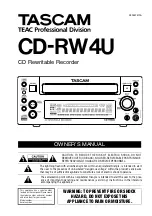
1 – Introduction—Special notes
TASCAM CD-RW4U
9
aging of CD-R discs will include one of the follow-
ing logos:
By contrast, a CD-RW disc can be used in much the
same way as a CD-R disc, but the last track or tracks
recorded can be erased before the disc has been
“finalized”, and the space on the disc can be re- used
for other recordings. The packaging of CD-RW discs
will include one of the following logos:
However, you should note that an audio CD created
using a CD-RW disc may not play back satisfactorily
on every audio CD player. It will, naturally, be play-
able on the CD-RW4U. This is in no way a limitation
of the CD-RW4U itself, but is a property of the dif-
ference between the different types of media and the
methods used to read them.
CD-R discs created on the CD-RW4U, by contrast,
may be played satisfactorily on the majority of audio
CD players.
For details of disc brands that are known to work
well with the CD-RW4U, see “Recommended
media” on page 10.
Handling of compact discs
Observe the following:
• Always place the compact discs in the trays with
their label facing upward (compact discs can only
be played on one side).
• To remove a disc from its storage case, press down
on the center of the case, and lift the disc out, hold-
ing it carefully by the edges.
• Finger marks and dust should be carefully wiped
off the disc’s recorded surface with a soft cloth.
Unlike conventional records, the compact disc has
no grooves to collect dust and microscopic debris,
so gently wiping with a soft cloth should remove
most particles.
• Wipe in a straight motion from the inside to the
outside of the disc. Small dust particles and light
stains will have absolutely no effect on reproduc-
tion quality.
• Never use such chemicals as record sprays, anti-
static sprays or fluid, benzine or thinner to clean
compact discs. Such chemicals will do irreparable
damage to the disc’s plastic surface.
• Discs should be returned to their cases after use to
avoid serious scratches that could cause the laser
pickup to “skip”.
• Don’t expose discs to direct sunlight or high
humidity and temperature for extended periods.
Long exposure to high temperature can warp the
disc.
• Only use circular compact discs. Avoid using non-
circular promotional, etc. discs.
• To keep the laser pickups clean, don’t touch them.
For the same reason, don’t leave the disc trays
opened unnecessarily.
Additional notes with regard to CD-R and CD-RW discs
There are additional precautions that you should take
when handling CD-R and CD-RW discs, that are dif-
ferent to those that you should take when handling
ordinary CDs.
• Avoid touching the recording (non-label) side of a
disc on which you will be recording. Recording on
a disc requires a cleaner surface than playing back,










































